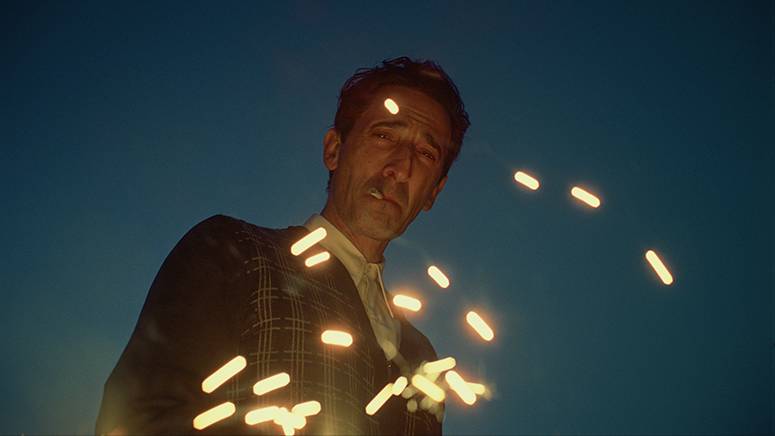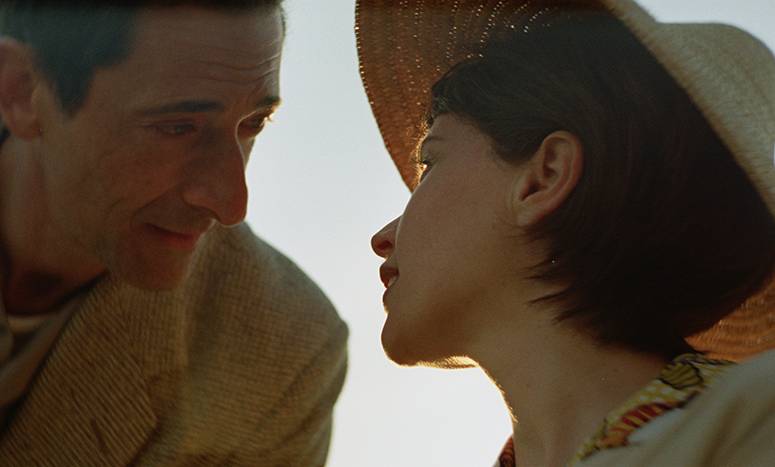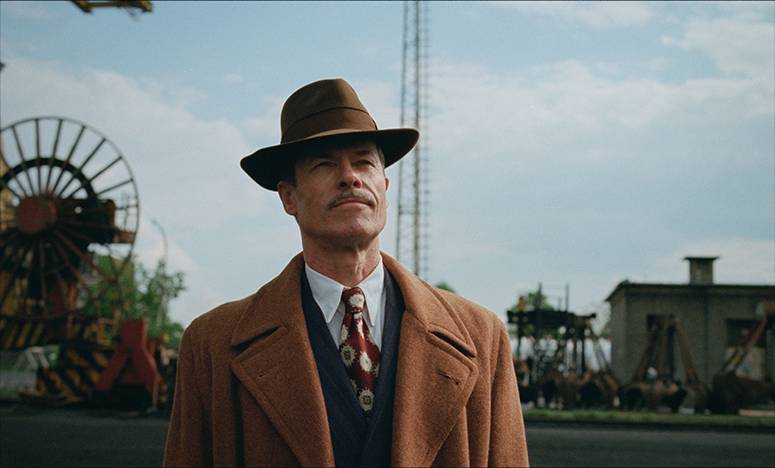Edifice complex
László Tóth, played by Adrien Brody in The Brutalist, arrives on a ship in darkness to Ellis Island in 1947, trapped below decks only to emerge into a blue-sky view of the Statue of Liberty, which is—from his perspective—upside down. That symbolism recurs near the end of Brady Corbet’s three-and-a-half-hour epic with a view of an upside-down cross, its outline reflected in a nearly completed church project initiated by industrialist Harrison Lee Van Buren Jr. (a crafty Guy Pearce), a man who made his money during the war and now wants to create a monument to his own benevolence.
Two pillars of America, served up through a cock-eyed lens.
The Brutalist is a story of America, and like most films nominated for a Best Picture Oscar this year, it’s about immigrants. (Others addressing the “outsider” condition include Wicked, Emilia Perez, Anora, Dune: Part Two, A Complete Unknown, and Conclave). You could say immigration is on people’s minds these days.

But The Brutalist, despite its prodigious length and ambitious scope, is essentially about László, a Hungarian-Jewish Holocaust survivor and Bauhaus-trained architect, and his wife Erzsébet (played by Felicity Jones whose performance creeps up on you). Their separation—more than their reunion, in fact—is the core of the story. But while most films would present flashbacks to Dachau and Buchenwald, where the couple learned how to survive apart, it’s the moments of László and Erzsébet’s marriage, reunited in Philadelphia and then working on Van Buren’s project, that tell us more: their painful reconnection, their underlying thread of sacrifice. Erzsébet realizes what a difficult man she married; she loves him no less.
Brody, as László, is visceral, unnerving. At times, you don’t know whether to applaud his audacity, or punch him in the face. He has hungry eyes, you can tell: He takes in everything, but never suffers fools gladly. He’s arrogant, like some Ayn Rand architect you secretly admire. But he also weeps copiously at the absence of his wife and niece Zsófia (Raffey Cassidy).

When László is hired by Van Buren’s son to remodel his father’s dusty old library into a sleek study, he can only shrug when the father rages at the modern design and refuses to pay. László’s used to not being understood in America.
The Brutalist is a film that reminds those who need reminding that immigration brings new ideas, new visions. But also new problems, new challenges. Whereas what has always sustained American power is old ideas, ideas as old as time: greed, bigotry, exploitation.
When Van Buren eventually hunts down the fired designer to show him a magazine clipping praising his “forward-thinking” library, he hires him for an even more ambitious project: a community space designed with László’s harsh lines and concrete foundations in mind. What unfolds in The Brutalist echoes many films where an ambitious project shapes the arc of the story and its characters—like Citizen Kane, with its Xanadu mansion, or P.T. Anderson’s There Will Be Blood and The Master. Movies about big projects usually require big payoffs, and The Brutalist, in the end, spends more time world-building than really digging deep into its characters’ motivations. Suffice to say, they are asked to adapt to their new world in America, and jettison the old.

When László finally brings his wife and niece over to America, they live in quarters adjacent to Van Buren’s grand unfolding project: a community center, including a library, theater, gymnasium, and chapel.
By then, we’re at the midpoint, and a clock counts down a 15-minute intermission—like films of old such as Gone with the Wind, Lawrence of Arabia, or 2001: A Space Odyssey—as we patrons stretch our legs for the second half.
Brody, Pearce, and Jones are very good, each in their own way, and it’s a testament to these three that we don’t feel the running time much, nor require an intermission; we want to know what happens next to László, Erzsébet and Van Buren. They feel real.

For a Hungarian emigree, László speaks English poetically: He claims he felt satisfaction, knowing he had built things in Hungary that would outlast him, even the Soviet occupation of Budapest after the war: “My things were made to endure the erosion of the Danube shoreline,” he tells Van Buren, matter-of-factly.
One big theme here is the difficulty of genius, and László’s problem is he can’t stand cookie-cutter thinking at the expense of beauty. It makes him hard to work with, someone the Van Burens come merely to “tolerate.”
Another big theme is the predatory nature of capitalism, and its intolerance of “outside” talent. Van Buren respects László’s mind, but he—along with many characters here—is suspicious of cleverness and raw talent; he envies it, but comes to hate it, even though he needs it to fulfill his grand schemes. The Brutalist might take this predation theme a little too literally, and an epilogue set in the 1980 Venice Architectural Biennale feels somewhat tacked-on, a pat tribute to László’s genius that tries to explain too much too quickly.
But Corbet has built such a lavish edifice here, and its architecture is so convincing, that we are content to gape at its unfolding, all the clever side panels and careful lines drawing us further into the story. It’s the opposite of the Bauhaus mantra: Function here follows form, and it’s the journey, not the destination, that lingers.
* * *
The Brutalist opens exclusively at Ayala Cinemas March 5.



